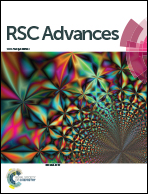Organic–inorganic hybrid: a novel template for synthesis of nanostructured Ag†
Abstract
We herein demonstrate that the amino acid arginine (Arg) can interact with phosphotungstate (Keggin) anions generating an excellent template for the synthesis of nanostructured silver wherein the Arg–PTA hybrid host plays the role of a UV-switchable reducing agent. The binding strength of the complex between arginine and phosphotungstate (PW12O40)3− i.e. the Keggin ions in aqueous medium has been assessed by the isothermal titration calorimetric technique. It is shown that the Arg–PTA complex may be used as a new class of organic–inorganic scaffolds in the synthesis of nanostructured silver. The crystalline Arg–PTA host can be photochemically reduced, resulting in electron transfer to the entrapped silver ions to form nanoparticle assemblies on the underlying colloidal template.


 Please wait while we load your content...
Please wait while we load your content...